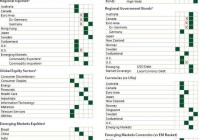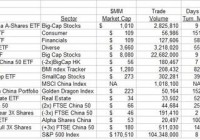The U.S. stock market is caught in a bull-bear tug of war this year. On the one hand, the domestic economy has been on a moderate growth path as reflected in increased consumer confidence, higher spending power, renewed optimism in housing recovery and an improving job market. Additionally, a wave of mergers and acquisitions are brightening up the stock world. On the other hand, Fed uncertainty, an aging bull market, lofty stock valuations, strong dollar, lower oil prices, and global growth concerns including Greece crisis and China slowdown are awakening the bear. As a result, both major indices – the S&P 500 and Dow Jones – are in the red territory from a year-to-date look, declining 0.4% and 1.5%, respectively. In fact, a number of products have been crushed by this tug of war, piling up huge losses for many ETFs. Below, we have highlighted four ETFs that have been hit badly in the volatile environment and might continue their rough trading in the months ahead if the same trends persist. C-Tracks ETN on CVOL (NYSEARCA: CVOL ) – Down 41.3% Volatility products have been the biggest laggard this year despite the bouts of volatility seen in the market. This is because these products tend to outperform when markets are falling or fear levels over the future are high, but neither of this has happened lately. While global headwinds tried to dominate the market, upbeat economic data and the Fed continued to fuel a rally at regular intervals. Given this, CVOL – linked to the Citi Volatility Index Total Return – was the hardest hit, having lost over 41% in value so far in the year. The note provides investors direct exposure to the implied volatility of large-cap U.S. stocks. The benchmark combines a daily rolling long exposure to the third and fourth month futures contracts on the CBOE Volatility Index with short exposure to the S&P 500 Total Return Index. The ETN is unpopular and illiquid in the volatility space with AUM of $4.5 million and average daily volume of less than 102,000 shares. It charges a slightly higher 1.15% in annual fees from investors. Market Vectors Coal ETF (NYSEARCA: KOL ) – Down 29.9% Coal has been out of investors’ favor over the past few years on the thriving alternative energy space and weak global industry fundamentals. The depletion of fossil fuel reserves, global warming and high fuel emission issues, new and advanced technologies as well as more efficient applications is making clean power more feasible, reducing the demand for the black diamond. These are making it difficult for the coal miners to sustain their profitability and margins. As a result, the ETF targeting the global coal industry has seen a wild ride and was off nearly 30% so far this year. It tracks the Market Vectors Global Coal Index. Holding 32 securities in the basket, the fund is concentrated on the top 10 holdings at 60.8% of total assets. It definitely has a U.S. focus as roughly 35% of the fund goes to the American stocks. Beyond that, the Asia and Asia-Pacific region combined to make up for 58% share. The fund has amassed $70 million in its asset base and trades in average daily volume of 77,000 shares. Expense ratio came in at 0.59%. KOL has a Zacks ETF Rank of 5 or ‘Strong Sell’ rating, suggesting their continued underperformance in the coming months. SPDR S&P Metals and Mining ETF (NYSEARCA: XME ) – Down 26.6% The other major losers in the equity world year-to-date are the metal & mining stocks and ETFs thanks to plunging metal prices and weak global trends. Acting as leveraged plays on underlying metal prices, metal miners tend to experience huge losses than their bullion cousins in the slumping metal market. In particular, a strong U.S. currency is making dollar-denominated assets more expensive for foreign investors, thereby dulling the appeal for these commodities. The ETF offers broad exposure to the U.S. metal and mining industry by tracking the S&P Metals & Mining Select Industry Index. Holding 34 stocks in its basket, it uses an equal weight methodology and does not put more than 4.53% of assets in a single security. In terms of industrial exposure, steel makes up for large chunk at 42.7%, while diversified metals and mining, aluminum, and coal & consumable fuels round out the next three spots with double-digit allocation each. The product has $263.3 million in AUM and trades in solid trading volumes of nearly 1.9 million shares per day on average. It charges 35 bps in fees and expenses and has lost about 26.6% so far in the year. First Trust ISE-Revere Natural Gas Index ETF (NYSEARCA: FCG ) – Down 22.7% Natural gas has been following the similar path that of the crude oil. After showing some stabilization at the start of the second quarter, the commodity again lost its charm in recent weeks due to a combination of factors. The shale oil boom in the U.S., increased production, supply glut and reduced demand are pushing natural gas prices and the related ETFs lower. FCG, which offers exposure to the U.S. stocks that derive a substantial portion of their revenues from the exploration and production of natural gas, is down nearly 23% in the year-to-date time frame. It follows the ISE-REVERE Natural Gas Index and holds 29 stocks in its basket, which are well spread out across components with none holding more than 4.89% share. The fund has amassed $197.3 million in its asset base while charging 60 bps in annual fees. Volume is good with more than 843,000 shares exchanged per day on average. The ETF has a Zacks ETF Rank of 4 or ‘Sell’ rating with a High risk outlook. Link to the original article on Zacks.com

